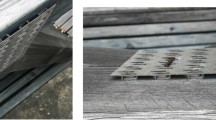Abstract
Timber trusses, typically manufactured from timber members connected by nailplates, are widely used in the domestic housing market. Their use is however limited to indoor environments. The exposure of timber trusses to environments where the timber experiences high amounts of moisture content (MC) variations causes the nailplates to be driven out from the surface of the timber, a phenomenon commonly referred to as “backout”. As part of a collaborative project between the industry, Griffith University and Queensland Department of Agriculture and Fisheries (DAF), this paper aims at investigating solutions to both prevent backout of the nailplates and increase their withdrawal resistance under large MC variations. The nailplate teeth were redesigned following (1) a mechanical approach consisting of redesigning the tooth profile and allowing the nails to resist the withdrawal force by both friction and mechanical action and (2) the application of an adhesive to a redesigned tooth profile, allowing the adhesive to penetrate the timber with the nail. The efficiency of the new designs was experimentally assessed using single teeth (representative of nailplate teeth) with respect (1) to their ability to resist backout resulting from accelerated MC cycles and (2) their quasi-static withdrawal resistance after increasing numbers of moisture cycles. Results showed that the proposed mechanical designs reduced the backout by up to 50% when compared to currently used tooth designs. The application of an adhesive prevented moisture driven backout. The newly investigated tooth designs resulted in higher withdrawal strengths to currently used nails. It was identified that subjecting the nails to only one moisture cycle reduced the withdrawal resistance of currently used and glued teeth by up to 60% while the withdrawal resistance of the proposed mechanical designs was not affected by the number of cycles.















Similar content being viewed by others
References
Allday A (2017) Wooden structural component manufacturing in Australia. IBISWolrd IBISWorld Industry Report C1492
ANSI/TPI 1-1995: National design standard for metal plate connected wood truss construction. American National Standards Institute (1995), New York, New York
Atkins WB (1962) Connector plate. United States of America. US3016586A
Bylund D (2017) Enabling prefabricated timber building systems for class 2 to 9 buildings. F. a. F. D. Australian Government Department of Agriculture Project number: PNA324-1314
Foschi RO (1977) Analysis of wood diaphragms and trusses. Part I: diaphragms. Can J Civ Eng 4(3):345–352
Gebremedhin GK, Crovella LP (1991) Load distribution in metal plate connectors of tension joints in wood trusses. Trans ASAE 34(1):281
Groom LH (1994) Effect of moisture cycling on truss-plate joint behavior. For Prod J 44(1):21
Groom L (1995) Effect of moisture cycling on mechanical response of metal-plate connector joints with and without an adhesive interface. New Orleans, Louisiana, United States Department of Agriculture—Forest Service—Research Paper so-291—September 1995
Guo W, Song S, Jiang Z et al (2014) Effect of metal-plate connector on tension properties of metal-plate connected dahurian larch lumber joints. J Mater Sci Res 3(3):40–47
Houška M, Koc P (2000) Sorptive stress estimation: an important key to the mechano-sorptive effect in wood. Mech Time-Depend Mater 4(1):81–98
Mainey AJ, Gilbert BP, Baillieres H, Gunalan S, Smith M (2016) Mechanical and artificial improvement of nailplate connected timber truss joints. In: Proceedings of the 10th World Conference on Timber Engineering WCTE2016. Vienna, Austria
McAlister RH (1990) Tensile loading characteristics of truss plate joints after weathering and accelerated aging [1990]. For Prod J 40(2):9–15
Melton T (2000) Failures of in-service mpc parallel-chord wood floor truss components reveal deficiencies in ansi/tpi standards. A. E. Inc., Austin
O’Neill W, Gabzdyl JT (2000) New developments in laser-assisted oxygen cutting. Opt Lasers Eng 34:355
Paevere P, Nguyen MH, Syme M, Leicester RH (2008) Nailplate Backout—is it a problem in plated timber trusses. In: Proceedings of the 10th World Conference on Timber Engineering WCTE2008, At Miyazaki, Japan
Paevere P, Nguyen M, Syme M, Leicester R, Ho K (2009) Mechano-sorptive nailplate backout in nailplated timber trusses. F. W. P. A. Limited, Australia
Regan PJ, Woeste FE (2002) Withdrawal strength of punched metal tooth plates in red oak end grain. (Wood Engineering). For Prod J 52:82+
Smith GC et al (1988) Wood joint connector plate. United States of America. US4734003
Smulski S (1993) Case study: flat truss failure. J Light Constr 38:39
Standards Australia (2001) AS1649-2001 Timber—methods of test for mechanical fasteners and connectors—basic working loads and characteristic strengths. Sydney, Australia, Standards Australia
Standards Australia (2006) AS/NZS 1748:2006 Timber—mechanically stress-graded for structural purposes. Sydney, Australia, Standards Australia
Standards Australia (2012) AS1080.1-2012 Timber—methods of test—moisture content. Sydney, Australia, Standards Australia & Standards New Zealand
Acknowledgements
The authors express their gratitude to Multinail Australia for providing the required support and material for the project. The main author also acknowledges the funding provided by the Australian Government Research Training Program Scholarship.
Author information
Authors and Affiliations
Corresponding author
Ethics declarations
Conflict of interest
On behalf of all authors, the corresponding author states that there is no conflict of interest.
Additional information
Publisher’s Note
Springer Nature remains neutral with regard to jurisdictional claims in published maps and institutional affiliations.
Rights and permissions
About this article
Cite this article
Mainey, A., Gilbert, B.P., Bailleres, H. et al. Solutions to reduce moisture driven backout and improve withdrawal strength of nailplates: experimental investigations. Eur. J. Wood Prod. 77, 257–269 (2019). https://doi.org/10.1007/s00107-019-01386-y
Received:
Published:
Issue Date:
DOI: https://doi.org/10.1007/s00107-019-01386-y




